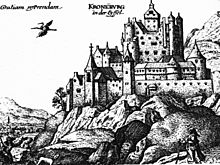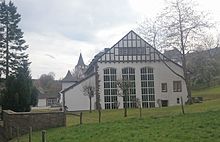Kronenburg
|
Kronenburg
Dahlem municipality
Coordinates: 50 ° 22 ′ 3 ″ N , 6 ° 28 ′ 46 ″ E
|
|
|---|---|
| Height : | 533 m |
| Area : | 16.13 km² |
| Residents : | 458 |
| Population density : | 28 inhabitants / km² |
| Incorporation : | 1st July 1969 |
| Postal code : | 53949 |
| Area code : | 06557 |
Kronenburg is a village in the German-Belgian border area of the Eifel and belongs to the North Rhine-Westphalian municipality of Dahlem in the Euskirchen district . It became known for its well-preserved, over 400-year-old, medieval townscape. Kronenburg consists of the high-altitude castle town of the same name and the valley settlement of Kronenburgerhütte .
On July 1, 1969, Kronenburg was incorporated into Dahlem ; In 1977 the place celebrated the 700th return of the first documentary mention. In 1992 the population was 450 people, and the number of those registered here with second homes increased continuously.
geography
location
Kronenburg is located in the Upper Kyll Valley between the Zitterwald and the Schnee Eifel . To the south are the mountains Steinert I with 635 m and Steinert II with 639 m.
Neighboring communities
In the south lies the local community of Ormont , in the west are the local communities Hallschlag and Scheid (all of Gerolstein , the district of Vulkaneifel , Rhineland-Palatinate ) and the district of Frauenkron , in the north the district of Berk , in the east the district of Baasem and Hammerhütte.
history
Kronenburg was first mentioned in 1277 in a document from the Imperial Abbey of Stablo-Malmedy . At that time, Kronenburg was ruled by the noble family of Dollendorf . For a short time from 1327 an independent Kronenburger line developed. When knight Peter von Kronenburg finally died in 1414 without male descendants, Kronenburg became a subsidiary of the County of Blankenheim-Manderscheid .
Under Charles V , Kronenburg fell under Spanish rule in 1555 due to its membership of the Duchy of Luxembourg until 1715 . For this reason, the former Spanish island in the Eifel is still called the “Spanish Ländchen” today. At the beginning of the 17th century, Kronenburg was hit by plague epidemics that lasted until 1680.
In 1794 Kronenburg was occupied by the French, under whose rule the place acted as the canton capital in the Ourthe Département . Kronenburg remained the mayor's office in the post-French period and at times also the seat of a notary . In the course of the redistribution of Central Europe after the defeat of Napoleon, Kronenburg initially came to the House of Mecklenburg-Strelitz as an exclave and only through an exchange or an advance payment in 1819 to Prussia .
In 1850 Kronenburg had 600 inhabitants. The ironworks that gave its name to the Kronenburgerhütte valley settlement had long since ceased operations and the majority of the remaining blast furnaces in the area (with the exception of the Jünkerathers) also went out during this time. In the course of the construction of the railway line from Jünkerath to Weywertz ( Ourtalbahn ), which opened in 1912 , Kronenburg was connected to the national railway network. From the beginning, however, the route had more military than civil significance and therefore had no economic impact. After the Second World War, apart from a few wood transports, there was no longer any noteworthy operation.
In the years between 1920 and 1925 there were Tell plays on the ruins of Kronenburg , performed by amateur actors from Kronenburg. In the 1930s, Professor Werner Peiner founded a painting school, which during the Nazi era was called the Hermann Göring Master School for Painting ; it was inaugurated in June 1942 by Hermann Göring . Well-known students of this painting school were Willi Sitte , Rolf Dettmann and Willi Wewer. The art academy was discontinued after 1945. The academy building is used by the state of North Rhine-Westphalia as an educational facility.
During the Second World War , valuable monstrances and reliquaries from the holdings of Cologne Cathedral were temporarily stored in the cellar of the Kronenburg rectory. Despite the nearby western wall , the Ardennes offensive at the turn of the year 1944/1945 and the severe destruction in the nearby town of Kyll , Kronenburg was hardly affected by fighting . A few Wehrmacht soldiers and SS officers surrendered to the advancing Americans in early 1945 after a brief resistance. At the end of the Second World War, Kronenburg had 350 inhabitants.
Culture and sights
Church of St. Johann Baptist
The construction of the parish church of St. Johann Baptist, also known as the “Johanniterkirche”, began in 1492 under Mathilde von Virneburg , the widow of Count Kuno von Manderscheid-Schleiden. The building, which is designed as a one-pillar church possibly based on the model of the hospital church in Kues , was completed in 1508. The church tower also served as an additional defensive tower for the castle complex. The name "Johanniterkirche" indicates the origins of church life in Kronenburg, which was established by a branch of the Order of St. John . The order, which had possessions in the Kronenburg area since the 13th century, provided the priests of the church until 1803.
St. Brigida Chapel
In 1736 the construction of the St. Brigida Chapel began, which was built directly on the Kyll by the residents of Kronenburgerhütte. At the beginning of the 20th century (1901) a small bell tower was added, the chapel renovated and the sacred space increased. The stained glass windows come from the Eifel painter Rolf Dettmann.
Castle
The Kronenburg fell mid-18th century. The Kronenburg Castle House was built in 1766 to manage the lands and ironworks that belonged to the Kronenburg rulership. The castle house was sold privately during the French era. It is the nucleus of tourism in the Upper Kylltal, as the well-known Nettchen Faymonville hosted the first holiday guests in the castle house at the beginning of the 20th century. In the 1990s, the building fell into disrepair and was temporarily empty. From 2006 to 2008 the building was extensively restored, expanded and converted into a 4-star castle hotel.
Former NS master school
In the former Hermann Göring Master School for Painting, there is now a state-owned "House for Teacher Training". The building by the Düsseldorf architect Emil Fahrenkamp , inaugurated in 1938, is a remarkable testimony to National Socialist building.
Hasenberghof
In the Hasenberghof (Rechtsstrasse 12) is the art gallery of Dr. Ax Foundation . It exhibits paintings from the Düsseldorf School of Painting . The collection is open on certain days, and there are special exhibitions with public tours at certain times.
The "Kronenburger Art and Culture Days" on the second weekend in September and the traditional Christmas market on the first weekend in Advent in the historic town center are of national interest.
In 2006 Kronenburg became a "gold village" when it won a gold medal in the state competition Our village has future , after it achieved 4th place in the district competition in 2005.
Freetime activities
Nearby, the Kyll is dammed up to the Kronenburger See . 1973 began with the construction of a melt and rainwater retention reservoir, which was completed in 1977. The lake is 27 hectares and is also used for recreational purposes. There is a leisure facility just a few meters from the shore. There is a holiday home complex on a slope above the lake . Kronenburg also offers many hiking opportunities, as large parts of the community area is covered with forest. The holiday region is part of the North Eifel Nature Park . A Christmas market takes place on the 1st weekend in Advent.
The railway line of the former Vennquerbahn has been expanded into a hiking and cycling route ( RAVeL network line 45a Waimes-Jünkerath ), with a connection both in Weywertz to the Vennbahn line and in Jünkerath to the German cycle path network.
Individual evidence
- ↑ Martin Bünermann: The communities of the first reorganization program in North Rhine-Westphalia . Deutscher Gemeindeverlag, Cologne 1970, p. 100 .
- ↑ Andreas Fasel: Controversial painter: Hitler's favorite - Peiner was in demand with the Nazis . June 5, 2012 ( welt.de [accessed June 18, 2019]).
- ^ Frank Möller: deutschlandfunk.de: Silence. Repressed. To forget? . Deutschlandfunk , September 5, 2014
- ↑ Cycle easily over 28 bridges , Kölnische Rundschau, accessed on June 6, 2011
literature
- Paul B. Steffen: "My constant desire to become a missionary one day". Wilhelm Gier was a master of the religious word , in: Jahrbuch des Kreis Euskirchen 1983, 19-25.
- Karl-Heinz Schumacher: Kronenburg. In: Geographical analysis of the structural use of natural stones in the Eifel. (= Aachen Geographical Works, Vol. 20). Aachen 1988. ISSN 0587-4068 , pp 135-162
- Karl-Heinz Schumacher: Comments on the building history and the status of monument preservation in the Kronenburg castle settlement. In: Eifeljahrbuch 1990. Düren 1989, pp. 79–91.
- Conrad-Peter Joist (ed.): The Eifel in the picture of the Kronenburger Malerschule . In: Landscape painter of the Eifel in the 20th century, Düren 1997, pp. 137–156
Web links
- Kronenburger interest group
- Reconstruction drawing by Wolfgang Braun









